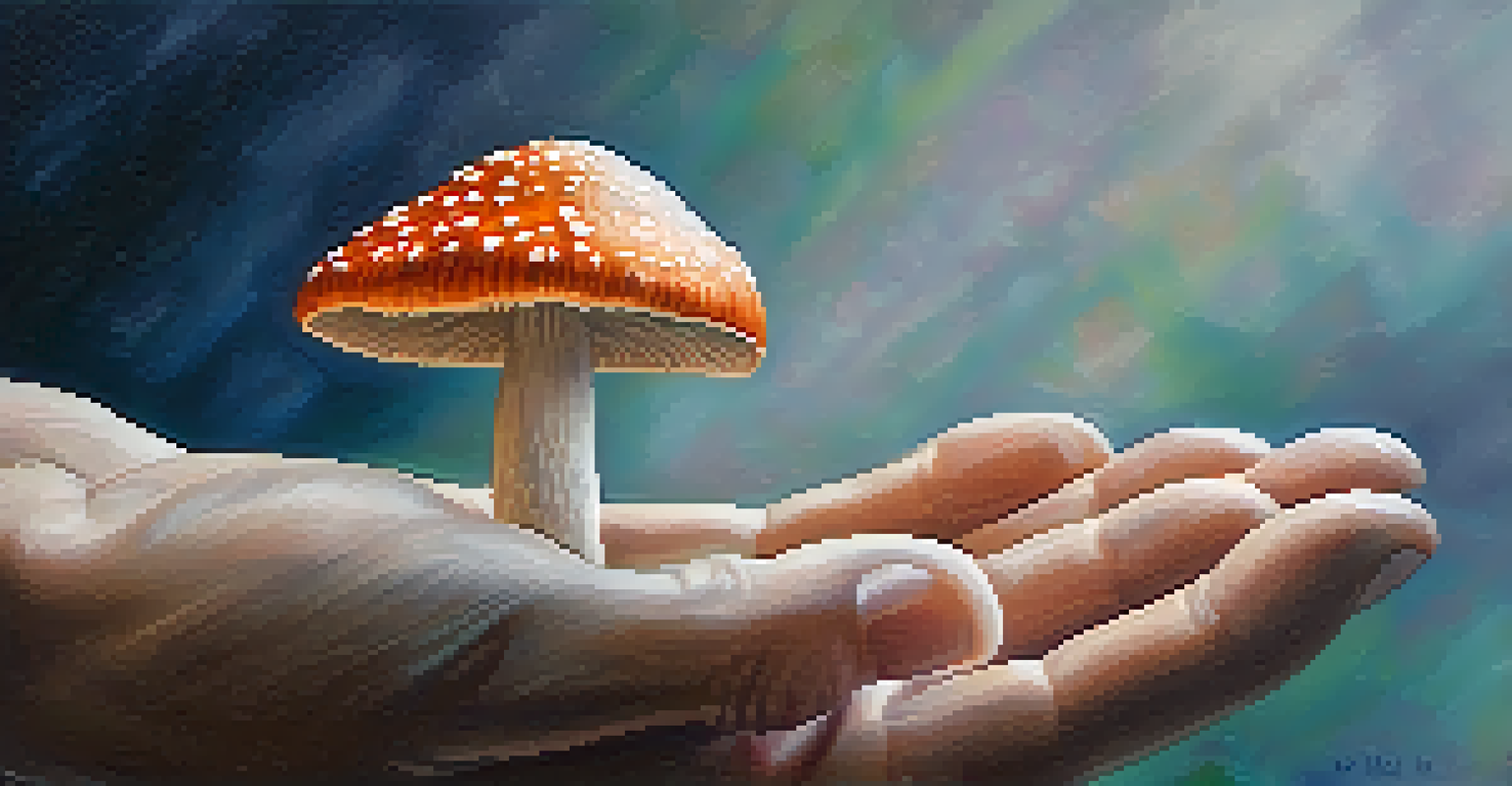Entheogens: Catalysts for Timelessness in Human Consciousness

Understanding Entheogens: A Brief Overview
Entheogens are substances that can facilitate profound spiritual experiences and alter consciousness. The term itself comes from the Greek words 'entheos' meaning 'filled with God' and 'genes' meaning 'producing.' This highlights their role in connecting individuals to a transcendent experience. Common examples include psilocybin mushrooms, ayahuasca, and peyote, each with a rich history of use in various cultures.
The experience of entheogens can lead to a profound understanding of oneself and the universe.
For centuries, different societies have employed these substances in rituals and spiritual practices. Indigenous tribes in the Amazon have long used ayahuasca in shamanic ceremonies, believing it allows them to communicate with the spirit world. Similarly, ancient Greek mysteries also utilized entheogens, suggesting a longstanding relationship between these substances and human consciousness.
The modern resurgence in interest around entheogens is not just cultural; it is also scientific. Researchers are now exploring their potential therapeutic benefits, particularly for mental health issues such as depression and PTSD. This growing body of work suggests that entheogens may hold the key to unlocking deeper layers of human consciousness.
The Historical Context of Entheogenic Use
Throughout history, entheogens have played crucial roles in various cultures and religions. The ancient Egyptians, for example, may have used certain plants in their rituals, while the Aztecs revered peyote as a sacred tool for spiritual insight. These practices demonstrate the longstanding human desire to explore the mysteries of existence and connect with something greater than oneself.

Additionally, the use of entheogens is not limited to a specific geographical area; they have appeared in diverse cultures around the globe. From the Soma of ancient India, described in the Vedas, to the sacred mushrooms used in Mesoamerica, each culture has its unique interpretation and application of these substances. This widespread use underscores their significance in humanity's quest for understanding and transcendence.
Entheogens Facilitate Spiritual Growth
Entheogens are substances that can induce profound spiritual experiences, leading to significant personal transformation and insights.
However, the narrative surrounding entheogens has not always been positive. With the rise of the War on Drugs in the 20th century, many substances were demonized, pushing their use underground. Today, as society reevaluates these substances, we are beginning to uncover the wisdom embedded in their historical context.
Entheogens and Spiritual Awakening
One of the most compelling aspects of entheogens is their ability to induce profound spiritual experiences. Users often report feelings of unity with the universe, deep insights into their lives, and even encounters with divine entities. These experiences can lead to a lasting transformation in how individuals perceive themselves and their place in the world.
Psychedelics can help us explore the depths of consciousness and open doors to spiritual insight.
Many people describe their journeys with entheogens as pivotal moments of personal growth. For instance, someone struggling with existential dread may find clarity and purpose after a single session. Such transformations highlight the potential for entheogens to serve as catalysts for spiritual awakening, opening doors to understanding that might remain closed through conventional means.
Importantly, the context in which entheogens are experienced can significantly influence the outcome of the journey. Guided sessions with trained facilitators, often in a ceremonial setting, can enhance the depth and safety of these experiences. This underscores the need for a respectful and intentional approach to their use, ensuring that seekers can maximize the benefits while minimizing risks.
The Role of Set and Setting in Experiences
When it comes to entheogenic experiences, the concepts of 'set' and 'setting' are paramount. 'Set' refers to the individual's mindset, including their thoughts, emotions, and expectations going into the experience. Conversely, 'setting' encompasses the physical and social environment in which the experience takes place. Together, they can profoundly impact the outcome of an entheogenic journey.
For example, someone entering an experience with anxiety in a chaotic environment may have a very different journey than someone who is calm and in a serene setting. By creating a supportive and comfortable environment, users can cultivate a positive experience that encourages exploration and understanding. This is why intentionality is crucial when preparing for an entheogenic session.
Therapeutic Uses of Entheogens Rise
Recent studies suggest entheogens may offer therapeutic benefits for mental health conditions like depression and PTSD, providing new avenues for healing.
Moreover, the integration of these experiences afterward is equally important. Reflecting on insights gained during the experience can help individuals apply newfound wisdom to their daily lives. This integration process can bridge the gap between the extraordinary and the mundane, enhancing personal growth and self-awareness.
Therapeutic Potential of Entheogens
Recent studies have started to reveal the therapeutic potential of entheogens in treating various mental health conditions. For instance, research on psilocybin has shown promising results in alleviating symptoms of depression and anxiety, particularly in terminal illness patients. This has sparked a renewed interest in understanding how these substances can be harnessed for healing.
Moreover, the treatment of PTSD with entheogens has gained traction, with veterans reporting significant improvements in their mental health after guided sessions. These findings suggest that entheogens could serve as powerful adjuncts to traditional therapy, offering new avenues for healing that were previously unexplored. Such advancements could redefine the landscape of mental health treatment.
However, it is essential to approach this research with caution. While the results are promising, further studies are needed to fully understand the long-term effects and potential risks involved. As we navigate this emerging field, ethical considerations must guide the use of entheogens in therapeutic settings, ensuring that safety and well-being remain the top priorities.
Entheogens vs. Traditional Pharmaceuticals
The comparison between entheogens and traditional pharmaceuticals is a topic of growing interest. While many pharmaceuticals aim to manage symptoms, entheogens often target the root of emotional and psychological issues, potentially offering deeper healing experiences. This fundamental difference raises important questions about how we approach mental health treatment in our society.
For example, traditional antidepressants can take weeks to show effects and may come with undesirable side effects. In contrast, a single session with entheogens can lead to profound insights and emotional breakthroughs within a much shorter timeframe. This efficiency could revolutionize how we view and treat mental health challenges, providing hope for many who suffer.
Set and Setting Impact Experiences
The effectiveness of entheogenic experiences is heavily influenced by the individual's mindset and the environment in which the experience occurs.
Yet, it's crucial to remember that entheogens are not a panacea. They require careful consideration, proper guidance, and integration to be effective. As research continues to unfold, finding a balance between the two approaches may offer the most holistic solution to mental health care.
The Future of Entheogens in Society
As societal attitudes toward entheogens shift, we are witnessing a renaissance in their study and use. Increasingly, communities are embracing their potential for healing and personal growth, leading to more public discourse and acceptance. This cultural evolution presents an opportunity to reshape how we think about consciousness and wellness.
Moreover, legal reforms in various regions are paving the way for regulated use of entheogens, particularly in therapeutic contexts. As more studies validate their benefits, we may see broader acceptance and integration into healthcare systems. This could signify a significant turning point in how we approach mental health and spiritual well-being.

However, with this newfound interest comes a responsibility to educate and inform users about safe practices. Ensuring that entheogens are used respectfully and thoughtfully will be vital to their successful reintegration into society. As we look to the future, the potential of entheogens to enrich human consciousness remains an exciting frontier.